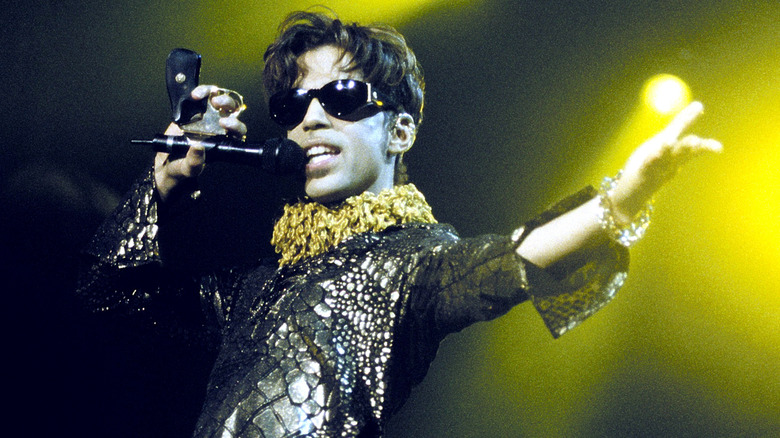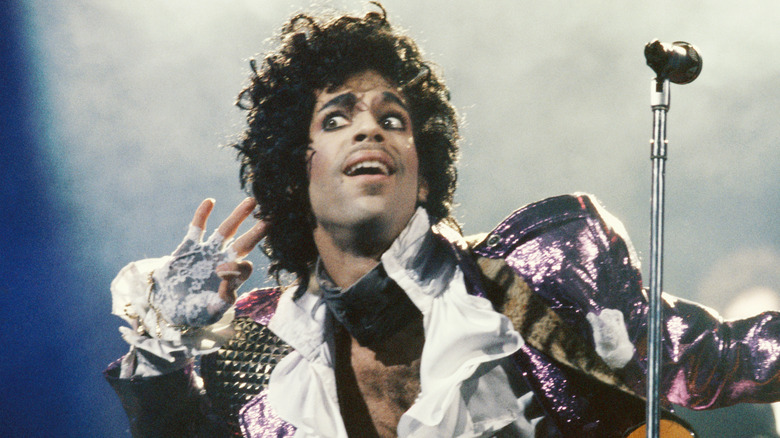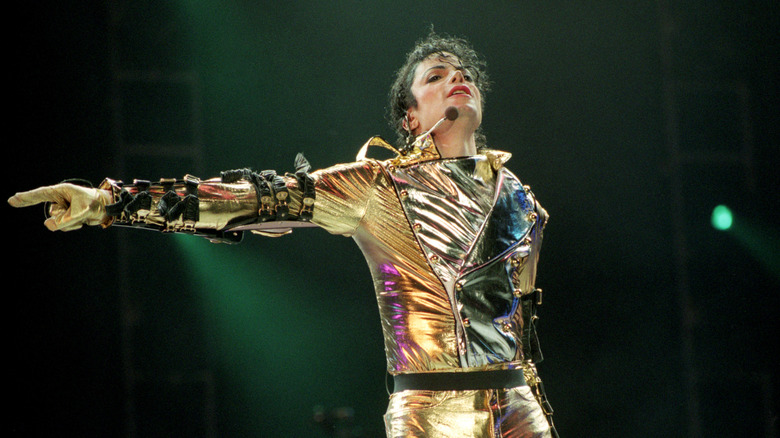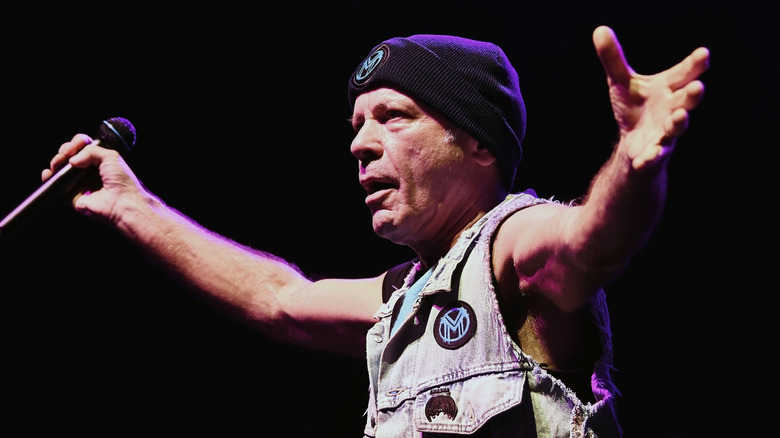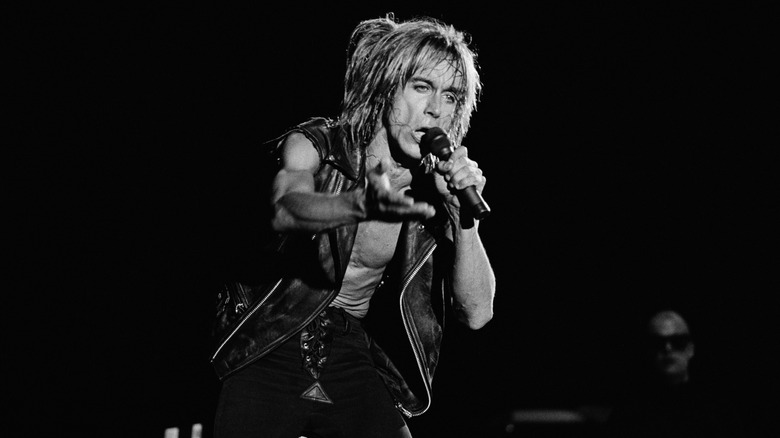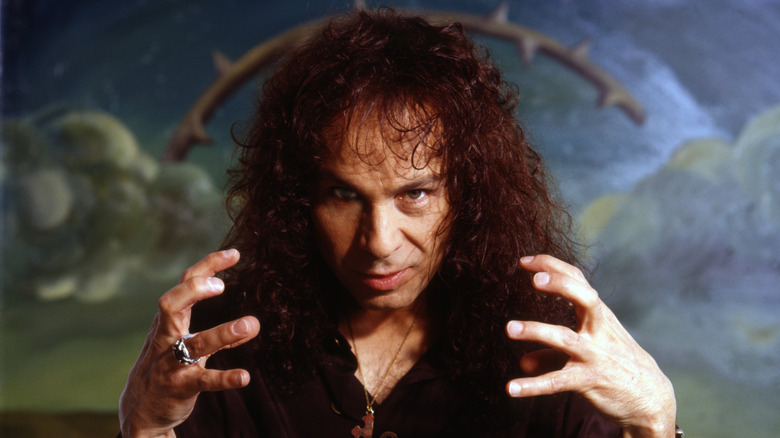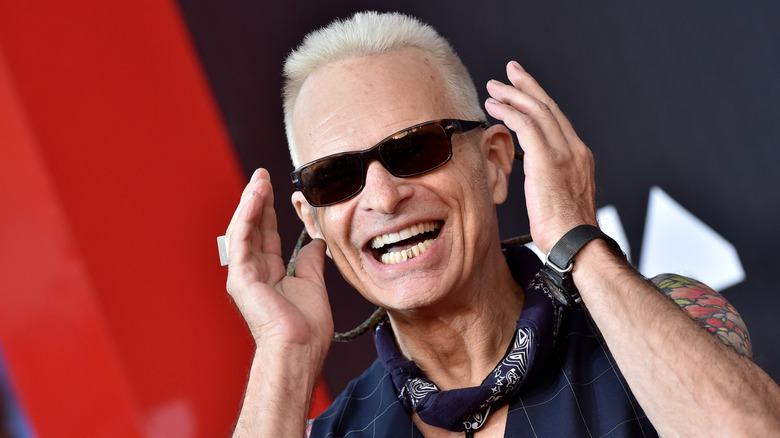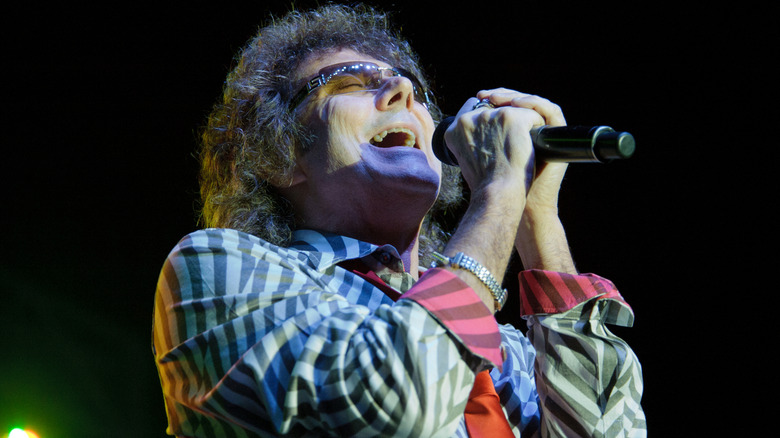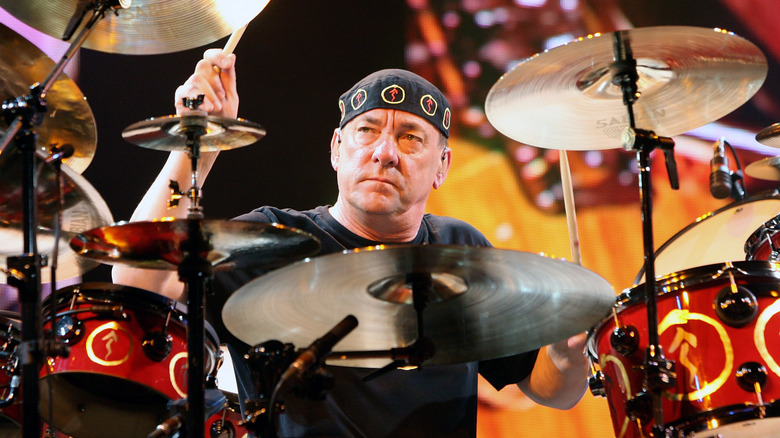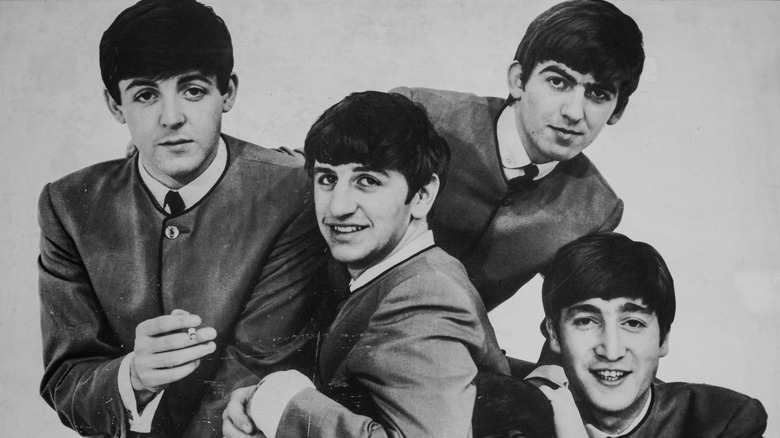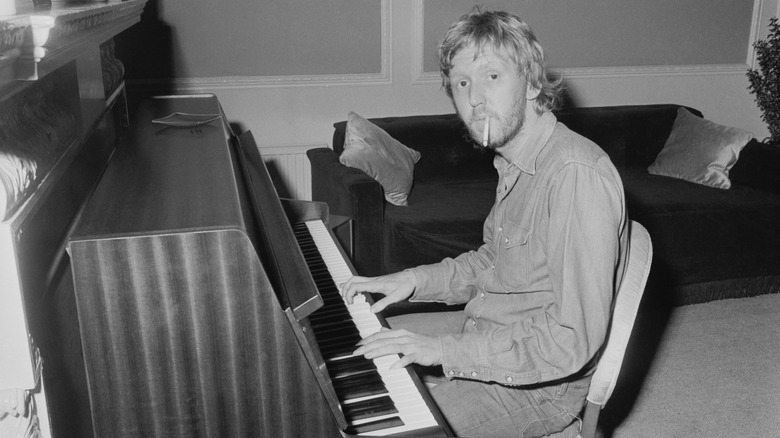Weird Details People Just Ignore About These Famous Musicians
If you are a musician, or if you have one or two amongst your circle of friends, then you know they are wired differently from most people. They may react to everyday stimuli, particularly sounds, in unusual ways; they may appear to be bopping to tunes only they can hear; they might casually drop song lyrics into conversations that have nothing to do with music. They are, in short, kind of weird.
It's also a fact that fame can do interesting things to people's brains, which is understandable. When half the world recognizes you and is heavily invested in everything you do, you tend to view the world a bit differently from, say, the guy who delivers your Doordash order. So, it really shouldn't surprise us when famous musicians have facets to their lives and personalities that are, shall we say, outside of the norm. That being said, you should probably get ready for a few surprises. Here are some details about some of your favorite muscians that they didn't exactly try to hide, but which most of us either don't know or (perhaps more likely) didn't believe.
Mick Jagger allegedly bought a mansion on LSD
It's safe to say there will never be another rock star like Mick Jagger, and some time ago, book publisher John Blake came into possession of what can only be described as the Golden Tome of Rock Weirdness: a 1981 memoir penned by the Rolling Stones frontman, comprised of 75,000 words that he literally had no recollection of having written. (Probably because of drugs.) After sitting on this manuscript for awhile, Blake decided in 2017 to offer up a few choice cuts for public consumption. Among these: the story of how Jagger had come to purchase Stargroves, a ramshackle mansion in Hampshire, without remembering having done so. (Probably because of drugs.)
While this anecdote is not exactly confirmed, the memoir spells out the details that Jagger had paid 55,000 pounds to the estate's owner, a man by the extra-British name of Sir Henry Carden, in 1970 while completely off his face on LSD. Upon coming to his senses, Sober Mick decided to make the most of Tripping Mick's exploits by converting part of the property into a recording studio. In this studio, the Stones would lay down tracks that appeared on classic albums like "Exile on Main Street" and "Sticky Fingers." Jagger would also ensure that severe intoxication would continue to be a part of Stargroves' legacy by loaning out the studio to the likes of Led Zeppelin, Bob Marley and the Wailers, and Iron Maiden.
Prince was really, really good at basketball
Pretty much the entire world knows that the late, legendary Prince Rogers Nelson was a musical talent without equal. Many of his fans, especially the hometown ones, know that he was a huge fan of basketball; he could often be seen courtside supporting his beloved Minnesota Timberwolves. Fewer, though, know that Prince was not just a fan of the sport — he was a disciple. That is to say, he was a straight-up baller.
Although he was only 5 foot 2, Prince made the basketball team in both junior high and high school. After his 2016 death, Al Nuness, his coach at Minneapolis Central High, told the Associated Press that Prince had a natural talent for the sport. "He was very small, but he was quick," Nuness said. "He could handle the ball and he could penetrate and he could dish." In 2004, Charlie Murphy, the late brother of Eddie Murphy, hilariously recounted a mid-'80s encounter with the Purple One during an appearance on "Chappelle's Show." After inviting Murphy and several of his friends to his sprawling mansion to listen to tunes, Prince challenged them to a game of hoops — and he and the Revolution proceeded to wipe the floor with Murphy and his crew. ("I mean, it wasn't even like it was close," Murphy recalled.) Having been suitably humbled, Murphy and the boys were then brought back inside, where they were served pancakes, because this is Prince we're talking about.
Michael Jackson's unusual credits
The late King of Pop Michael Jackson was famous for pretty much his entire life, which is the kind of circumstance that will have you handing the tabloids new and increasingly bizarre stuff to write about you every single week as a full-grown, world-conquering pop star. Aside from the often extreme weirdness of his private life, though, Jackson was prone to making professional choices that, while not widely known, were interesting to say the least. For one, he actually deigned to sing backup vocals on the 1990 "Simpsons"-themed novelty single "Do the Bartman," and even gave the tune its name — and this was even before his legendary guest appearance on the 1991 episode "Stark Raving Dad."
Perhaps even more odd was Jackson's partnership with video game company Sega, which produced his "Moonwalker" series of games. Owing to that relationship, Jackson contributed a bunch of music (uncredited) to 1994's "Sonic the Hedgehog 3," which sharp-eared fans noticed contained some tunes that sounded suspiciously Jackson-esque even back then. Jackson declined to be credited when the 16-bit Sega Genesis somehow did a subpar job of replicating his contributions with its sound engine, but in 2022, "Sonic" creator Yuji Naka confirmed the superstar's involvement.
Eddie Van Halen snapped on Fred Durst
In his 2020 photobook "Eruption in the Canyon: 212 Days & Nights With the Genius of Eddie Van Halen" (via Ultimate Classic Rock), video director Andrew Bennett related a story about how, at the behest of a label exec, the legendary guitar virtuoso ended up at Fred Durst's Beverly Hills home jamming with Limp Bizkit. Upon realizing that he was a "scholar amongst kindergartners," as Bennett put it, Van Halen peaced out, leaving behind some of his gear.
When Durst ignored repeated inquiries about returning said gear in the following days, Van Halen may have gone a bit too far in response. "Eddie once bought an assault vehicle from a military auction," Bennett remembered. "It [had] a shine gun mount on the back and [was] not legal. Eddie drove that assault vehicle through L.A., into Beverly Hills, then parked and left it running on the front lawn of the house Limp Bizkit was rehearsing in." Van Halen then knocked on the door, and when Durst answered, he oh-so-politely requested that his gear be immediately returned (a request which may or may not have been augmented by the presence of a firearm). The guitarist then calmly stood on the lawn having a smoke while Durst and his panicked companions dragged amps and guitars out to his Death Car.
Billy Idol vs. the actual army
During his '80s heyday, Billy Idol operated at a god tier in terms of sheer rock and roll debauchery; the fact that he is, as of this writing, still around and rocking is nothing short of a miracle. This reached its apex in 1989, when Wild Bill decided to deal with his breakup from longtime girlfriend Perri Lister by holing up in a hotel in Thailand for several weeks and going all Keith Moon on the place.
Over the better part of a month, Idol dove headfirst down a well of drugs and property damage (at one point, he was found passed out in an elevator by Mel Gibson, of all people), and apparently figuring that a quarter-million dollars in damages weren't quite enough, he was refusing to leave. One might have expected management to call the cops, but they did not; no, they called in a local unit of the freaking army, who promptly strapped Idol to a stretcher and carted him out. Many rockers might claim to be the hardest of partiers, but if any of them have ever partied so hard that a military response was required, we'd like to hear about it.
Bruce Dickinson is one of the most impressive people on Earth
For most of their decades-long run, legendary British metal band Iron Maiden has been fronted by Bruce Dickinson, one of the metallest metallers to ever metal, and one of the oldest heavy metal icons still alive today. For most people, being perhaps the most visible member of one of the greatest metal bands of all time would be enough, but Dickinson is not most people. He has also mastered a number of other skills that would be lifelong endeavors for most mere mortals; for starters, he's a world-class fencer, having trained with the British Olympic team during his band's heyday in the '80s. He's also famously a licensed commercial airplane pilot with over 7,500 hours under his belt, and even flew "Ed Force One," Maiden's touring aircraft, for years.
Also, in 2013, Dickinson and the band partnered with English brewery Robinsons to create a line of Maiden-inspired beers, all of which Dickinson had a hand in designing. One style in particular, an ale with an especially aromatic body, was conceived by Dickinson after he lost most of his sense of taste due to the treatments for the cancerous tumors he had developed on his tongue. Not a problem, that; he made a full recovery and continued with all of his pursuits, including performing with Maiden and carving out an ongoing solo career. His seventh solo album, "The Mandrake Project," was released in 2024.
Iggy Pop challenged an entire biker gang to a fight
In the early '70s, nobody outside of the seedier parts of New York City had seen anything like Iggy Pop and the Stooges, whose proto-punk stylings subscribed to the twin credos of "play loud" and "no, way louder than that." In 1974, the band was playing a small club in Warren, Michigan, when they encountered a crowd uniquely unsuited to their onstage antics: one composed almost entirely of members of a biker gang who were there to welcome a new member by way of beating him senseless.
The aggressive heckling started almost immediately after the band began playing, so naturally, Pop responded by doing everything in his power to make the situation worse. He and the band launched into a sloppy, repetitive, 45-minute-long version of "Louie, Louie" with altered lyrics consisting of improvised insults toward the crowd. He waited until said crowd reached a boiling point before launching himself into the audience and basically attempting to fight them all, which of course resulted in the singer getting beaten senseless (although this did not, apparently, result in his being made a member of the gang). Pop somehow managed to drag himself back onstage and continue playing until he was no longer contractually obligated to do so. The following day, during an appearance on a local radio station, Pop invited the whole gang back for a subsequent show in Detroit — and they obliged, chucking bottles at the band as Pop egged them on.
Brian May built his own guitar
Queen's Brian May is another rocker whose secondary interest could have made a respectable profession for most mortals, and he tends to take a hands-on approach to those interests. As a kid, he built his own telescope; in adulthood, he became an astrophysicist who has consulted with NASA. It may not be terribly surprising, then, to learn that the lead guitarist for one of the most successful bands ever built his own guitar as a teenager — the "Red Special," the axe he has used for his entire career.
Young May was already proficient on the acoustic guitar, but his working-class family didn't have the means to purchase a new electric model. Fortunately, May's father was an electrical engineer and also incredibly resourceful, and he and his son embarked on a two-year project to create the instrument that would carry May and his bandmates to international stardom. The axe was constructed from wood sourced from such objects as an old fireplace mantle and an oak table, and created entirely by hand tools. All of the other elements — the whammy bar, tremolo system, pickups, everything — were built by hand and underwent several revisions before they were deemed acceptable. Queen's '70s and '80s peers may have racked their brains trying to figure out how May achieved his singularly distinctive sound, but they need not have bothered; he simply used a guitar that was quite literally one of a kind.
Ronnie James Dio started out as a crooner in the '50s
One could argue that Ronnie James Dio was the most powerful vocalist to ever sing metal, and one would win that argument a hundred percent of the time. His tenures in Rainbow and Black Sabbath, along with his distinguished career as a solo artist, are the stuff of legend — but you may not know that he basically came out of the womb playing music. And that, at least at first, this music was not metal. And that his first instrument was the trumpet.
Dio also played bass guitar, and he was playing in bands as a teenager in the '50s, a time when metal notably did not exist. His first moderately successful unit was a band called the Vegas Kings, who later rebranded to (wait for it) Ronnie and the Red Caps. It was under this moniker, in 1961, that the band released "An Angel Is Missing," a lovely ballad which featured the future King of All Metal crooning the lead vocal. This band later retitled themselves yet again (to Ronnie and the Prophets) before morphing into Elf, a much heavier unit that pointed the way toward Dio's eventual fronting of Rainbow. In a 2001 interview, Dio said, "[Ronnie and the Red Caps] was the beginning of it all for me, that's where you kind of learn what you're all about and find out that this is what you want to do for the rest of your life. We wore silly hats, but in those days, you did silly things" (via Louder).
Rick Derringer's musical soulmate
Guitarist Rick Derringer was a music legend; he scored his first hit with his band The McCoys in 1965 at the age of 17, the No. 1 smash "Hang On Sloopy." He landed another Top 40 hit in 1974 as a solo artist, "Rock and Roll Hoochie Koo," before going on to become an ace session musician. His work could be found on hit tunes by artists as diverse as Steely Dan, Air Supply, and Bonnie Tyler; he laid down the guitar solo on the latter's immortal hit "Total Eclipse of the Heart." He was also a producer, working with the likes of Edgar Winter and Cyndi Lauper — and forming an unlikely musical partnership with one of the most beloved artists of our time.
In the early '80s, Derringer produced the self-titled debut LP by "Weird Al" Yankovic, and the pair got along so well that he ended up producing five more for the comedy maestro. Derringer even took home a Grammy for his production work on "Eat It," Al's hit parody of Michael Jackson's "Beat It," on which he also laid down a blazing guitar solo to rival Eddie Van Halen's original. Speaking with Grammy.com in 2023, Yankovic recalled, "The whole solo is, I don't know, 10 seconds long. But I remember Rick did the solo, and he went from being completely dry to being drenched in sweat in under 15 seconds. He put everything into that thing."
Jack White is a furniture upholsterer
Before becoming the world-famous guitarist and frontman for The White Stripes, Jack White was just a dude from Detroit trying to earn an honest living. Shortly before the Stripes took off, White was working as an upholsterer's apprentice under a guy named Brian Muldoon, who happened to be a musician himself. The pair formed a short-lived garage rock band called — you guessed it — The Upholsterers, and even pressed up copies of a couple of their singles on vinyl.
Legend had it that White and Muldoon had slipped several copies into pieces of furniture they were reupholstering, and as it turned out, the legend was true. In 2014, it was announced on the website of White's label, Third Man Records, that two copies of the Upholsterers' tune "Your Furniture Was Always Dead," had been found. Apparently, this phrase and variations thereof had stuck with White over the years. In a 2011 NPR interview, it was pointed out that "Your Furniture's Not Dead ... I Was Just Afraid to Tell You" was the slogan of his and Muldoon's business, which had been called Third Man Upholstery. He had adapted this slogan for Third Man Records to "Your Turntable's Not Dead." When this was pointed out by the interviewer, White quipped, "I don't know what I'll do if I open a funeral home."
David Lee Roth was a licensed EMT
As the frontman for Van Halen before Sammy Hagar took over in the mid-'80s, David Lee Roth cultivated what one might call the stereotypical rock star image: hard-partying, flamboyant, and not just a little hotheaded. He has kept this image up into his 70s, still rocking after five decades — but if his pursuits outside of music are any indication, Roth is a man who contains multitudes.
In 2004, it was revealed on EMS World, a website dedicated to Emergency Medical Service professionals, that Roth had actually become an EMT, and at the time of the article's publication, had been on over 200 outings in that capacity in an unnamed Bronx neighborhood. His trainer, Linda Reissman, was quoted as saying, "You would never know you were dealing with a rock and roll guy. His commitment really is touching. He wants to help people." Roth himself opened up about the experience years later, during a 2021 profile on "CBS Sunday Morning." "I wasn't someone until I put on that ... uniform and went on my first call," Roth said. "I knew I was in for [a] humbling experience."
Ric Ocasek lied about his age for decades
Cars frontman Ric Ocasek is one of the most unique figures in all of rock — a gaunt, skinny oddball with light-socket hair and the face of a human-alien hybrid. Ocasek used a hiccuping, at times nearly atonal vocal style to deliver lyrics that ranged from poetically weird to maddeningly opaque. It was an aesthetic that was somehow perfect for his band, which blended chilly synths, red-hot guitars, and rock-solid beats into a perfect new wave stew. He was also one of those rock stars who left his wife for a much younger woman, divorcing his second wife Suzanne for 23-year-old model Paulina Porizkova in 1988. This raised a few eyebrows due to their 16-year age difference, but it probably would have raised a few more if it had been publicly known that Ocasek was actually even older than he let on.
In a 1979 Rolling Stone interview, Ocasek — then 34 years old — had gone ahead and shaved five years off his age when asked. This one interview came to be the go-to source for every journalist who ever cited the singer's age in all the years to come, and Ocasek never corrected them. Upon his death in 2019, most people thought he was 70 — but public records soon materialized indicating that he had actually been 75. Surprising, but perhaps not exactly shocking, that such an enigmatic figure would have kept a relatively trivial secret about himself for pretty much his entire professional life.
Thomas Dolby's court battle for his stage name
Most people know synth master Thomas Dolby for one reason, and one reason only: Because his 1982 smash hit tune "She Blinded Me With Science" is so freaking catchy that it's been lodged in the public consciousness for four decades. His résumé is actually quite impressive — he's lent keyboards and production work to acts as diverse as Foreigner, Def Leppard, David Bowie, and rap pioneers Whodini. But that icy, science-y hit song, performed by an artist with a surname that instantly evokes electronics wizardry due to its association with the famous audio company Dolby Laboratories, will forever be Dolby's calling card. In fact, so strong is the association between the name "Dolby" and tech know-how that Dolby Laboratories once sued the musician for trademark infringement.
You see, Dolby is actually a stage name — the artist was born Thomas Robertson, but picked up his moniker in school because of his strong technological bent. In 1986, Dolby Laboratories took issue, as Dolby (the musician) was beginning to dabble in music for film, and Dolby (the sound reduction guys) didn't want movie audiences to get confused. Unsurprisingly, the case was thrown out, as it was determined that Dolby had indeed used that name for pretty much his entire life, and that it was in no way an attempt to cash in on the image or reputation of Dolby Laboratories. It's just a good thing that Dolby's school buddies didn't decide to name him "Thomas Dreamworks" instead.
Mickey Thomas, who sang the 'worst song ever,' is a killer vocalist
There are widely maligned pop tunes, and then there is Starship's 1985 single "We Built This City," one of the most annoying smash hits ever recorded, and a tune that many, many people regard as one of the worst songs ever made. Musically tepid and lyrically ridiculous (thanks to longtime Elton John lyricist Bernie Taupin), the track features co-lead vocals by the legendary Grace Slick and Mickey Thomas, who had joined the band when it was still Jefferson Starship in 1979. Said vocals are, well, karaoke-level, phoned-in hokum — so it stands to reason that even those who tolerated the tune in the '80s likely didn't know that Thomas is actually a blindingly talented vocalist.
Thomas had been a backup singer for blues guitarist Elvin Bishop, who promoted him to lead for his 1976 Top 10 hit "Fooled Around and Fell in Love." Upon joining Jefferson Starship as a replacement for founding vocalist Marty Balin, Thomas immediately made a splash with his searing lead vocal on the No. 14 hit "Jane," a certified banger and a classic rock radio staple to this day. In 1985, the rechristened Starship decided to go in a much fluffier direction which, while far less rocking, yielded their biggest chart successes. While Slick has joined the "worst song ever" bandwagon with respect to "City" in recent years, Thomas has defended the tune, writing in a 2019 email to music critic Bob Lefsetz that he's "very happy for the pleasure that [it] brought, and continues to bring, to people all over the world."
Rush's lyricist isn't who you think
Canadian power trio Rush tends to be a pretty divisive band, despite the fact that all of its members were so stupidly talented that it bordered on unfair. Guitarist Alex Lifeson is one of the most underrated axe men ever, vocalist and bassist Geddy Lee could do both of those things and play keyboards all at the same time, and drummer Neil Peart was ... well, he was Neil freaking Peart, one of the greatest to ever sit behind a kit. The band's detractors tend to cite Lee's voice, which is admittedly an acquired taste, and his lyrics, which could be a touch too literary and high-minded for some fans. What just about nobody knew, though, was that Lee wasn't responsible for those ultra-cerebral, collegiate scholar-level words — Peart was.
In a 2021 conversation with Rolling Stone, Lee shared that Peart, who had joined the band after their first album, was basically pressed into service as a lyricist because he "[read] a lot of books," and neither Lee nor Lifeson was really invested in writing. Although Lee admitted to struggling with Peart's wordiness at first, they eventually came to work in tandem just as effectively as lyricist and singer as they did as drummer and bassist. "[For] many years, [Peart] sat beside me in the control room when we listened back to vocals," he said. "If we talked about something that could be improved, he would rewrite it on the spot ... Neil was a perfect example of a guy who checked his ego at the door."
Karen Carpenter was more than just a great singer
The Carpenters, the brother-sister duo of keyboardist Richard and vocalist Karen, were not exactly known as a hard-rocking band. Their '70s hits like "We've Only Just Begun" and "Close to You" are as comforting as lullabies, thanks in large part to the qualities of Karen Carpenter's voice: crystalline, soothing, and perfectly suited to, well, "Rainy Days and Mondays." It was that voice that propelled the band to no fewer than 12 Top 10 hits, including three number ones — but as great a singer as she was, it's her skill as a drummer that is not just underrated, but criminally overlooked.
Thanks to the band's ubiquity in the '70s, from their tons of hit songs to their TV specials in which Carpenter occasionally got to show off, music fans of that decade were a bit more in the know. In 1975, a Playboy poll named her as the best drummer in the world, ahead of folks like John Bonham, Ginger Baker, and Keith Moon. If that sounds like hyperbole, it may be worth checking out a clip from one of those specials in which she just wrecks all of the drums, or a 1968 TV appearance in which she completely owns a simple four-piece kit while performing "Dancing in the Street." She may have been widely known as a singer of lovely pop tunes, but as a drummer, she wasn't just good, or even great — she was elite, a fact that drumming giants such as Hal Blaine and Buddy Rich have publicly attested to.
The Beatles shared a little secret
The impact of The Beatles on popular music can't be overstated; their innovations in songwriting and studio techniques transformed the face of popular music, to the point that for decades now, there have been college-level courses offered at universities in the U.S. and U.K. dedicated to dissecting just what it was that made the most influential rock band of all time so freaking great. While there is plenty to explore on the topic, there is at least one area in which none of the Fab Four excelled: the reading and writing of musical notation. That is to say, none of them could do it.
The Beatles composed and played everything by ear, which if anything might make them even more impressive. Their years together honing their skills as a live act before their ascent to worldwide fame likely made it a bit easier to be on the same page (so to speak) as songwriters, and producer George Martin, a classically trained musician and composer, helped fill in any blanks. In a conversation with Colgate University's website (one of the higher learning institutions that offers Beatles-centric courses), music professor Marietta Cheng posited that the band did not consider this to be a blind spot or a deficiency — quite the contrary. "They were experimenting with their songwriting to make it original," she explained. "By not knowing the rules of grammar in music, it meant they could try anything they wanted to try."
Harry Nilsson was a pioneer in unexpected ways
Singer-songwriter Harry Nilsson was as eclectic as they came; incredibly prolific, and just as prone to playful goofiness as heart-wrenching balladry. Among his most well-known works are "One," famously covered by Three Dog Night, and his version of Badfinger's "Without You." Nilsson's muse was known to take him to some pretty odd places, including a couple which would be explored by DJs and EDM producers years after his time.
In 1967, Nilsson was working on recording a cover of the Beatles' "You Can't Do That," when he realized that one of the tune's main chords was featured in quite a few of the band's songs. He began folding in snatches of lyrics from those songs, one after the other, until he ended up with a bizarre pastiche that included elements from over a dozen songs yet somehow ran just over two minutes. This is widely considered to be the first mashup, and Nilsson also pioneered the remix by way of smashing together his 1967 album "Pandemonium Shadow Show" and the 1968 release "Aerial Ballet" into one big, weird album, titled (of course) "Aerial Pandemonium Ballet," in 1971. He would shortly thereafter release the Grammy-nominated LP "Nilsson Schmilsson," taking home a statue for Best Pop Vocal for "Without You" — but perhaps his most lasting contributions to music came from his incessant fiddling around.
Billy Joel started out in a terrible metal band
Everybody knows and loves Billy Joel; he's the Piano Man, one of the greatest ever on that instrument and an ace singer-songwriter who has had dominating runs on the pop charts. Early in his musical career, though, he was in search of an identity. The one he almost landed on would have been unfortunate in the extreme; he would later go on to call his first significant musical project a "colossal failure," and we should all thank the music gods that this was the case. The name of the band was Attila, and it featured Joel attempting to play crunching heavy metal riffs on a Hammond organ fed into a giant stack of amplifiers.
Somehow, this aesthetic failed to make any impression other than a highly negative one. In a 1985 interview, Joel said, "We had about a dozen gigs and nobody could stay in the room when we were playing ... We drove people literally out of clubs ... We were so loud. You could see blood coming out of people's ears. It was just horrible" (via Louder). This may or may not be hyperbole, but the band's sole release lends credence to the "horrible" part. In a review for AllMusic, Stephen Erlewine wrote, "By the end of the album, it feels as if a drill has punctured the center of your skull — it's that piercing, painful, and monotonous. Joel has gone on record describing the results as 'psychedelic bulls***.' Remove the word 'psychedelic' and you have an accurate description."
